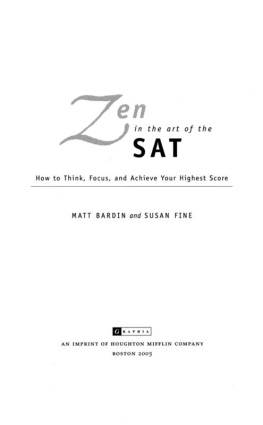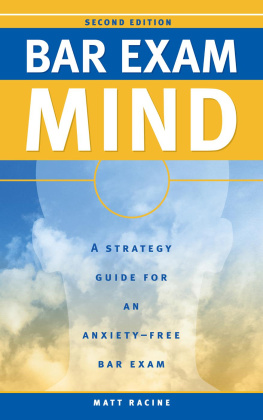G RAPHIA
AN IMPRINT OF HOUGHTON MIFFLIN COMPANY
BOSTON 2005
Copyright 2005 by Matt Bard in and Susan Fine
All rights reserved. Published in the United States by Graphia, an imprint of
Houghton Mifflin Company, Boston, Massachusetts.
For information about permission to reproduce selections from this book, write to Permissions,
Houghton Mifflin Company, 215 Park Avenue South, New York, New York 10003.
www.houghtonmifflinbooks.com
The text of this book is set in 9.5-point Palatino.
SAT is the registered trademark of the College Board, which has not endorsed this publication.
Library of Congress Cataloging-in-Publication Data
Bardin, Matt.
Zen in the art of the SAT : how to think, focus, and achieve your highest score /
written by Matt Bardin and Susan Fine,
p. cm.
ISBN 0-618-57488-3 (pbk.: alk. paper)
1. Scholastic Assessment TestStudy guides. I. Fine, Susan. II. Title.
LB2353.57.B36 2005 378.1'662dc22 2005004326
ISBN -13: 978-0618-57488-9
Book design by Hanley | Jones Art + Design
Manufactured in the United States of America
QUM 10 9 8 7 6 5 4 3 2 1
To all the students who have been
willing to skip and come back
Contents
Introduction
IThe Nature of the Test
1 In a Foreign Land
2 Walk Through the Open Door
The New SAT at a Glance
IIThinking
3 The Key to Better Thinking: Skip and Come Back
4 When to Skip and When to Come Back
5 Beginner's Mind: How to Come Back
6 Reasons Not to Skip and Come Back (and Why They're Wrong)
7 An Example: Erica Works the Test
8 From "I Can't" to "I Can"
IIIAnxiety
9 The Buddha and the SAT
10 Anxiety and the Present Moment
11 Breathing
12 Basic Meditation: Managing Anxiety
13 Assessing Your Anxiety
14 Anxiety Examples
IVReading
15 Reading Challenges
16 Reading Habits That Get in the Way and How to Correct Them
17 Reading Assessment
18 How to Raise Your Reading Level
19 Critical Reading Strategies
VSome Things You Must Know
20 The Big Ten: Grammar and Usage
21 Math Strategies
22 Math Basics
23 Math Quiz
24 The Basics of Timed Writing
VIParents
25 Taking Your Parents Down Memory Lane
26 Seven Damaging Remarks Well-Meaning Parents Make
27 The Five Characteristics of Supportive Parents
VIIYour Plan
28 Organization: How's Your Brain's CEO?
29 Just Twenty-five Minutes
30 You Can Run a Marathon: Creating an SAT Study Plan
Getting-Started Checklist
VIIILife Lessons
31A Crisis Is a Critical Opportunity
32 Feelings Are First, but the Mind Leads
33 Beginner's Mind (Reprise)
34 The Myth of Genius (and Stupidity)
Appendices
Recommended Reading List
Vocabulary
About the Authors
Introduction
There is only one time when it is essential to awaken. That time is now.
Buddha
What Is Zen and What Has It Got to Do with the SAT?
If you've heard the term Zen before, it might have been used in a sentence like "You just have to be Zen about it," which was offered as advice for getting through some unpleasant experience such as sitting at the kids' table at Thanksgiving. The implication is that Zen refers to an ability to endure through anything without much feelinga way to zone out or just be mellow about everything. Nothing could be further from the truth.
Zen evolved over the last thousand years in Asia as a way to purify one's life through meditation. More recently, people around the world have taken a strong interest in Zen. Many Americans, in particular, have found that the insights and practices of Japanese monks are effective antidotes to our stressed-out way of life.
Zen practice focuses on opening your mind to the present. Take a moment right now to hear all the sounds around youtraffic noise, birds, the hum of a refrigerator. Listening is a way to bring your attention into the present. Your mind rarely notices what you're hearing. Most of us dwell instead on thoughts that have nothing to do with the present. What will she think about what I'm wearing? How will I ever get all my work done tonight? Why did my history teacher give me that grade? How can I get my parents to let me use the car?
Zen teaches us that the thoughts that preoccupy us are not reality. As they clank around in our heads, reality goes on all around us. The goal of Zen practice is not so much to eliminate these thoughts as to become aware of their existence in our lives and to begin gently nudging them aside in order to give the present moment a larger place in our experience. When we let thoughts and worries about the past and future fall away, we become more aware of our existence in the moment, and we can concentrate on what's right in front of us. We also become aware of ourselves as part of a unity that is the universe.
Reading this book will not teach you to become one with the universe (though you may feel inspired to move in that direction on your own). The focus here is on a less global aspect of Zen practice known as samadhi, which means "being one with an object." In this case, the "object" we're talking about is a test: the SAT.
Samadhi is the state of mind that allows athletes and musicians to perform extraordinary feats. It allows lawyers to draft elegant contracts and artists to paint or draw or sculpt. Samadhi refers to a person's ability to bring total focus to a task through concentration. It is exactly the quality that the SAT demands.
A Critical Opportunity
How do you feel when you're taking a test and get a question about something you don't know? Your heart rate goes up. You might feel heat in your chest or your temples. If only you had read that chapter more carefully or memorized that formulabut now it seems there's little you can do. You make up some feeble nonsense in hopes of getting partial credit. Whether this happens to you all the time or almost never, it's one of the worst feelings you can experience as a student.
It's also something that you can count on experiencing while taking the SAT. However, on the SAT, this isn't necessarily a bad thing. It may even be a good thing.
In Japanese, the word for crisis (kiki) also means "critical opportunity." That's because every crisis can be a turning point. How you handle a crisis can make the difference between disaster and triumph.
At some point on the SAT, you may face a crisisthe anxiety caused by a question you initially think you can't answer. How you handle this crisis will determine how well you do. (And how you manage anxiety more generally will determine how well you do in lots of different things throughout life.) This book discusses the critical skills you need to do well on the SAT: reading, thinking, and managing anxiety. Reading and thinking are closely related on the test because many SAT questions can't be easily understood. Your brain has to break them down the way your stomach breaks down a pizza with too many toppings. From quirky math questions to complicated reading passages and the twenty-five-minute timed writing exercise, the challenges on the SAT can initially seem tricky if not impossible. Yet the guidance and suggestions offered here will teach you how to handle the test.
Next page



